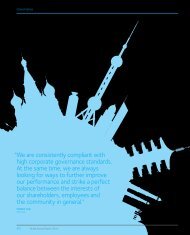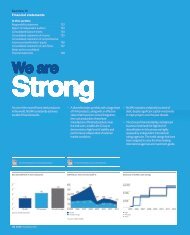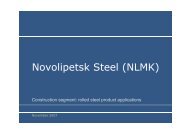NLMK Group
NLMK Group
NLMK Group
Create successful ePaper yourself
Turn your PDF publications into a flip-book with our unique Google optimized e-Paper software.
Panorama WORLD OF METALS 31<br />
pig iron. The first pig iron did not<br />
display any outstanding qualities.<br />
Soon, however, the Chinese came up<br />
with a new design for the furnace,<br />
called the Chinese cupola furnace,<br />
which was capable of producing pig<br />
iron in quantities sufficient to cast<br />
statuettes and bells. For the next<br />
two millennia or so the Chinese<br />
would hold a complete monopoly<br />
in terms of pig iron production. The<br />
first cupola furnaces would appear<br />
in Europe only in the XIII th century.<br />
Pig iron was in extremely high<br />
demand in Europe during the<br />
Industrial Revolution. Originally,<br />
tall furnaces (stuckofen; stuck<br />
means lump in German) and<br />
cupola furnaces were used to<br />
make iron for cannon balls; later,<br />
blast furnaces would produce iron<br />
to make the cannons; and in the<br />
XIX th century the use of coal in<br />
huge blast furnaces produced a<br />
deluge of pig iron. Iron became so<br />
abundant and its quality improved<br />
so much that it was used to<br />
manufacture almost everything,<br />
from cutlery to bridges and towers.<br />
In the late XIX th century giant<br />
furnaces designed by Pierre Martin,<br />
the French metallurgist, and<br />
relatively small Bessemer converters<br />
were used to produce steel from<br />
pig iron and scrap. In 1936 Soviet<br />
researcher N. Mozgovoy proposed<br />
to blast the pig iron with oxygen in<br />
a converter, thereby producing steel<br />
of better quality at a lower cost.<br />
Given its significant strength,<br />
steel made it possible to make<br />
things that had previously seemed<br />
impossible, like building a bridge<br />
with a central span of longer than<br />
one kilometer in the very turbulent<br />
waters of the San Francisco Bay,<br />
or covering a two-hundred meter<br />
building with an elegant latticework<br />
roof without using any support<br />
beams, or manufacturing a selfpropelled<br />
bullet-proof war machine.<br />
Better yet, by experimenting with<br />
steel alloys researchers were able to<br />
vanquish corrosion, steel’s eternal<br />
enemy. Stainless steel appeared<br />
in 1890, to be followed later by a<br />
variety of alloyed steels, including<br />
the so-called corten steel: sheets<br />
made of this type of steel are<br />
already affected by corrosion, which<br />
creates a thin film on their surface,<br />
thereby preventing steel from<br />
contact with oxygen and further<br />
corrosion.<br />
Today steel and pig iron are the<br />
most commonly used metallic<br />
alloys. They account for 95% of<br />
metals produced world-wide.<br />
Clearly, this requires large-scale<br />
production of iron ore, the reserves<br />
of which are limited. Currently<br />
there are 160 billion tonnes of<br />
explored iron ore reserves on the<br />
planet, and most of them are found<br />
in Brazil, Russia, Australia, China<br />
and Ukraine. Since pure iron<br />
accounts for only half of the mass<br />
of ore, while iron ore production<br />
last year has already reached 2.3<br />
billion tonnes, one could assume<br />
that a major metallurgical crisis is<br />
due in another 80 or 90 years.<br />
Fortunately, both steel and pig iron<br />
have very good recycling properties,<br />
and the supply of ferrous scrap is<br />
truly humongous. The metals<br />
recycling industry has been<br />
developing at a very strong pace<br />
year after year, giving hope that iron<br />
will continue to serve humanity for<br />
many centuries to come.<br />
Making bloomery<br />
iron during the Middle<br />
Ages<br />
In 1865 Pierre Martin,<br />
the French<br />
metallurgist, patented<br />
a new design for a<br />
steelmaking furnace,<br />
making it possible to use<br />
scrap in the production<br />
of steel

















